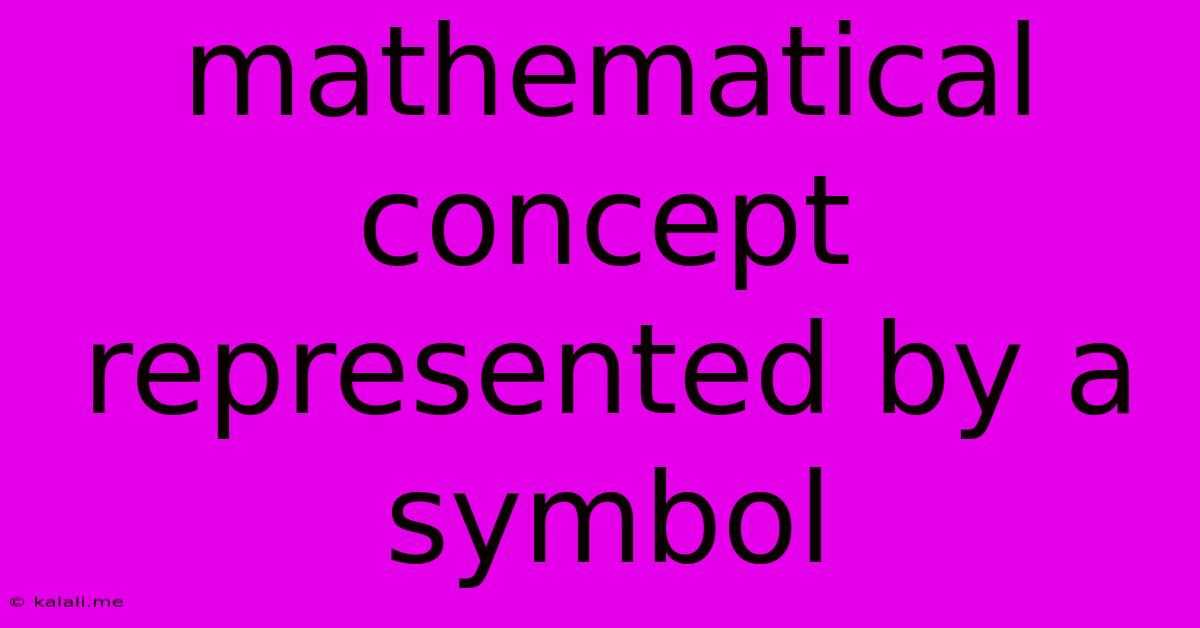Mathematical Concept Represented By A Symbol
Kalali
May 19, 2025 · 3 min read

Table of Contents
Mathematical Concepts Represented by Symbols: A Deep Dive
Mathematical symbols are the cornerstone of mathematical communication, providing a concise and universally understood language for expressing complex ideas. This article explores several key mathematical symbols, delving into their meaning, applications, and historical context. Understanding these symbols is crucial for anyone seeking to grasp the beauty and power of mathematics. This guide will cover various symbols used across different mathematical fields, from basic arithmetic to advanced calculus.
The Ubiquitous Plus (+) and Minus (-) Signs
Perhaps the most familiar mathematical symbols are the plus (+) and minus (-) signs, representing addition and subtraction respectively. These symbols, dating back to the 15th century, form the bedrock of arithmetic and are fundamental to all higher-level mathematical concepts. Understanding their basic functionality is crucial for any mathematical endeavor. Their simple representation belies their importance in everything from basic budgeting to complex financial modeling.
Multiplication and Division: ×, ÷, and the Dot (⋅)
Multiplication is represented by several symbols, including the multiplication sign (×), the dot (⋅), and often implicitly by juxtaposition (placing numbers side-by-side, like ab). Division, similarly, employs the division sign (÷) or a fraction bar (e.g., a/b). The choice of symbol often depends on context and the complexity of the equation. The evolution of these symbols shows how mathematical notation has streamlined over time for efficiency and clarity.
The Equals Sign (=): Equality and its Implications
The equals sign (=), introduced by Robert Recorde in 1557, signifies equality. It states that the expressions on either side of the symbol are equivalent. This seemingly simple symbol is pivotal in problem-solving, equation manipulation, and the logical development of mathematical proofs. Understanding the nuances of equality is vital for successful mathematical reasoning. This symbol underlies the very foundation of algebraic manipulation.
Greater Than (>) and Less Than (<): Inequalities and Order
The greater than (>) and less than (<) symbols represent inequalities. They indicate the relative size or order of two numbers or expressions. These symbols are crucial for defining ranges, intervals, and for working with inequalities in various mathematical contexts, including calculus and linear programming. Mastering these symbols is crucial for understanding order and magnitude relationships.
Other Important Symbols: ∞, π, Σ, ∫
Beyond the basics, numerous other symbols play critical roles in mathematics. Infinity (∞) represents an unbounded quantity. Pi (π), approximately 3.14159, represents the ratio of a circle's circumference to its diameter. The summation symbol (Σ) denotes the sum of a series, and the integral symbol (∫) represents integration in calculus. These symbols showcase the power of mathematical notation to represent complex operations concisely. Learning these symbols opens up the world of advanced mathematical concepts.
Conclusion: The Power of Mathematical Symbols
Mathematical symbols are more than just shorthand; they are the building blocks of a precise and universally understood language. Their ability to condense complex ideas into succinct expressions is a testament to the elegance and power of mathematics. By mastering the meaning and application of these symbols, one gains access to a deeper understanding of mathematical concepts and the ability to communicate mathematical ideas effectively. Continuous engagement with these symbols enhances mathematical fluency and problem-solving skills.
Latest Posts
Latest Posts
-
Codes For Harry Potter Lego 1 4
May 19, 2025
-
Stop Facebook Asking Me Connect To Instagram
May 19, 2025
-
How Long For Mortar To Set
May 19, 2025
-
Through Heaven And Earth I Am The Honored One
May 19, 2025
-
Did People Kissed Prphet Mohammed Hand
May 19, 2025
Related Post
Thank you for visiting our website which covers about Mathematical Concept Represented By A Symbol . We hope the information provided has been useful to you. Feel free to contact us if you have any questions or need further assistance. See you next time and don't miss to bookmark.